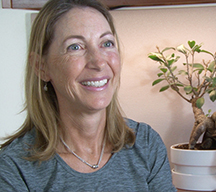Decoding Emotions and the Brain: A Profile of Lisa Stowers
By Madeline McCurry-Schmidt
Lisa Stowers, professor at The Scripps Research Institute (TSRI), sits in her office beneath two giant noses. They’re bookends, gifts from her mother, and especially appropriate for a scientist whose team is hard at work studying connections between the nose and brain.
Stowers’s goal is to discover how and where the brain processes emotion, with mice (and their responses to smells) as model systems. Her team is studying which molecules and genes are involved when an individual feels happy, scared or even angry.
“My lab is looking at emotion in a way other labs aren’t—by looking at how genes and proteins regulate this big, ‘fuzzy’ behaviorally related force called emotion,” said Stowers.
Her work aims to reveal the fundamental wiring of the brain. With this foundation, Stowers hopes, other researchers will have the background to understand what happens when brain function changes, as it does in autism and Alzheimer’s disease.
A Role Model in the Family
The human brain is insanely complex—its billions of neurons each have thousands of synapses, making it the most complex machine on the planet. On top of that, every person’s brain is different on the cellular level. DNA can even vary between cells in one individual brain.
That’s a lot to decode—which is what Stowers loves about neuroscience.
“It’s this huge black box,” said Stowers. “That’s really exciting for me.”
Stowers grew up in the Bay Area and is the first scientist in her family. She said she owes her interest in science to her grandmother, Gaye, a postal worker. “My grandmother could probably be described as an enthusiastic feminist and wanted me to do something that wasn’t a traditional ‘woman’s field,’” said Stowers.
Stowers started studying neurobiology as a graduate student at Harvard University. She remembers meeting just one female lab head in her department there. “There weren’t really any female role models, but—because of my grandma—it never occurred to me that I shouldn’t do it, or we shouldn’t try.”
When Stowers received her PhD in Molecular and Cellular Biology from Harvard University in 1997, her grandmother’s vision of women in the sciences was coming true across the country. According to the National Science Foundation, the proportion of women in the biosciences has risen steadily since the 1990s, with women now earning about 52 percent of biosciences PhDs.
This was also the time of the molecular biology “revolution” in neuroscience, when more scientists were able to go beyond observational studies of the brain and run controlled experiments to turn single neurons on and off and measure gene activation and signaling molecules. “That has allowed for amazing advances in understanding what makes one neuron different from another,” said Stowers.
Opening the Black Box
In the animal world, emotions are about survival. They tell an animal what is safe and what is a threat.
Researchers have found that they can prompt specific emotions by exposing mice to odor molecules called pheromones. Mice are hard-wired to feel fear if they smell pheromones from cat urine, for example. Researchers can then follow the path from the nose to the brain to find the molecules that encode that emotion—to see where the emotion lives.
Since joining TSRI in 2002, Stowers has uncovered several circuits that connect outside stimulation, emotions and the brain.
In 2007, Stowers and her team discovered specific pheromone compounds that trigger aggression in male mice. In 2012, her lab found that every mouse mother has a unique blend of odor molecules that prompt her pups to feel relaxed and start suckling. Both discoveries illustrated how emotions can govern brain function and behavior.
The Stowers lab also studies how the chemicals surrounding neurons can change their function. In 2015, the lab’s research made headlines when it determined that female mice cannot smell male pheromones when it is not time to mate. Without the right levels of hormones in their systems, the females were virtually “blind” to the males’ presence.
“The nose was making decisions and acting like an extension of the brain,” Stowers said. “I have never heard of anything like this before—in any sensory system.”
New Tools at TSRI
Stowers said the next step is to put all the pieces together, allowing scientists to see what happens when a mouse experiences many emotions over a long period of time.
Stowers and her lab members are also building up a library of 1,000 odor molecules, with the support of a recent $1.5 million grant from the National Science Foundation. With these new smells, the researchers will be able to prompt even more emotions and expand their blueprint of the brain.
Stowers knows she’ll never unravel everything about emotions and brain function—it’s just too complex. But that’s what she’s drawn to—the idea of chipping away at the big questions in science.
“When everything comes together, and you finally know something new about how the brain works that nobody knew before—that’s an awesome feeling,” said Stowers. “I feel so fortunate that I get to do this every day here at Scripps.”
Send comments to: press[at]scripps.edu















